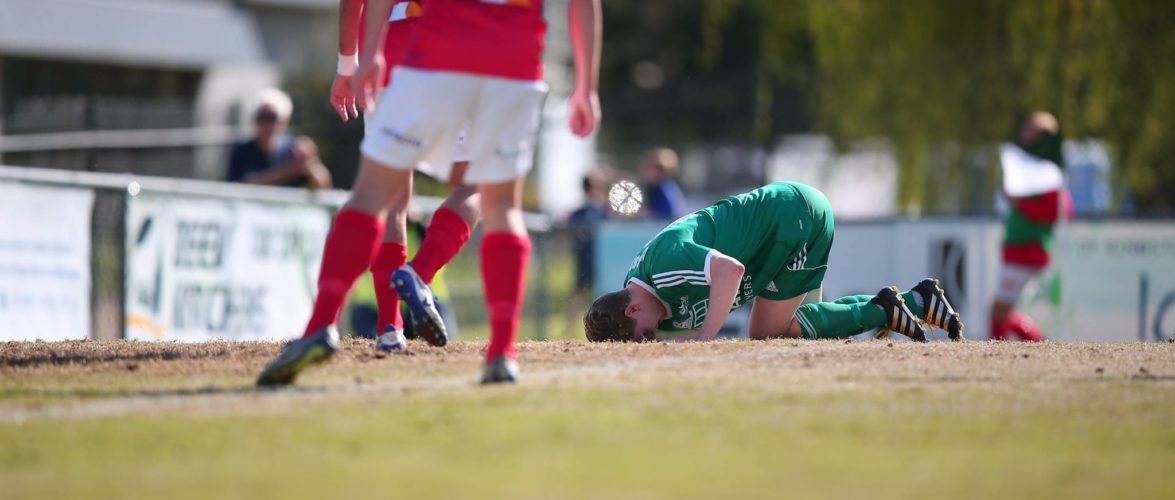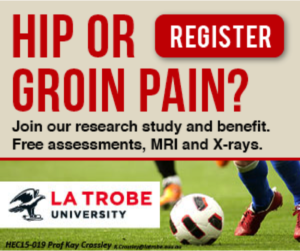Photo: Matt Johnson
While players enjoy a well-deserved break after a long hard season, coaches are busy planning for the upcoming pre-season training schedule.
One of the most common and frustrating injuries that football players experience during a pre-season training program are hip flexor strains. Research from the English Premier League and the AFL show that hip flexor injuries occur more often than hamstring injuries during the pre-season period[1, 2]. In addition, hip flexor and quadriceps injuries also occur often during the season and are associated with missed games[3].
The main focus of this article will be on a muscle known as rectus femoris. It attaches at the front of our pelvis, runs over the hip joint and attaches onto the knee cap via the quadriceps tendon. It is involved in extension of the knee, flexion of the hip and also contributes to maintaining pelvic position in standing.
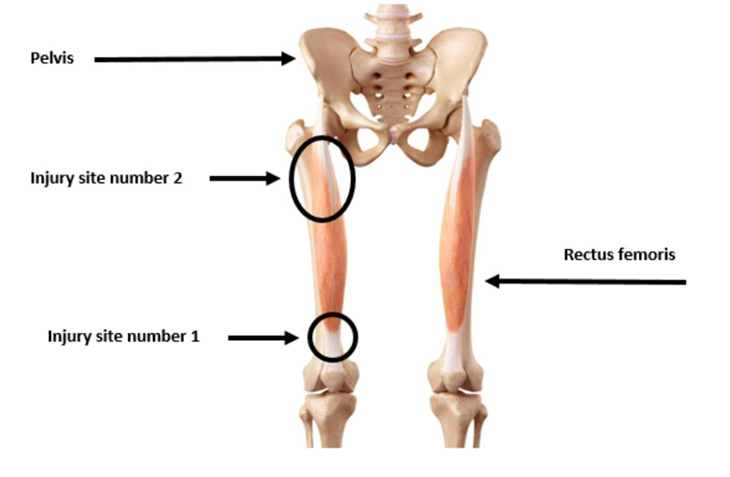
The location of the injury will often determine the severity and the amount of time that the player will be away from football. More often than not, players injuries will occur at injury site number 1[4]. Recently, research has highlighted that injuries occurring at injury site number 2 can be more serious than originally thought[5] and can involve prolonged periods of rehabilitation and in some cases require surgical intervention.
The most common reported mechanisms that can cause rectus femoris injuries are:
- Acceleration and deceleration during running[4]
- Kicking[4]
- Ball contact[4]
- Swing phase[4]
It does appear that some players are more at risk than other when it comes to this type of injury. Like previous articles I will break it down into factors that are modifiable and non-modifiable
***
Modifiable risk factors
Flexibility
Two studies[6,7] that investigated the association between flexibility and quadriceps injury demonstrated that professional football players with reduced thigh muscle flexibility were at increased risk of injury during the season. The flexibility target proposed is 128°, players with this amount of flexibility were at less of a risk of injury compared to players with flexibility less than 128°[6]. This is commonly assessed using the method in figure 1.
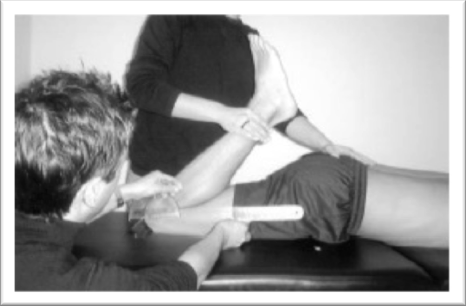
Strength
Reduced eccentric strength of the quadriceps muscles has been shown to place the player at increased risk of thigh muscle strains during the competitive season[7]. This is most applicable to football players as this will correspond with the “wind up” phase or the back swing of the kicking motion.
***
Non-modifiable risk factors
Age
Players who are older do not appear to be at increased risk of quadricep injuries[3]. This is very different to what is known about the increased risk of hamstring injuries as players age.
Previous injury
Players who have sustained quadriceps injuries in the past are at increased risk of future injury[8]. So what can be done to prevent quadriceps injuries?
Improving flexibility of quadriceps and hip muscles
It is important to target both the quadriceps and hip flexors with flexibility training. As mentioned before, we know that if you have reduced levels of flexibility in the quadriceps you will be at increased risk of injury[6]. Given that footballers will perform hours of kicking, it is not uncommon to become very tight in the hip flexors. This effectively means that the quadriceps and in particular rectus femoris have to work very hard during the kicking motion, exposing them to increased work and fatigue levels and potentially injury[4]. Flexibility can be achieved through use of stretching, appropriate strength training and other tools like foam rollers or massage balls.
Improving strength of hip flexors, quadriceps and surrounding muscles:
Hip flexors
The force producing capacity of the hip flexors is seen to be vitally important for generating foot speed in kicking[4]. If the primary hip flexors are weak, often overload of the quadriceps and in particular rectus femoris will occur. Strengthening of the hip flexors can be performed using strength bands or with cable machines at the gym[9], a commonly given exercise for hip flexors can be seen in figure 2.
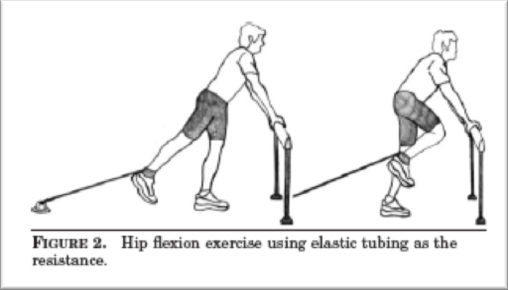
Quadriceps
With muscle strain injuries thought to occur when the muscle is placed at long lengths, the use of eccentric strengthening is thought to be of upmost importance. Some commonly used exercises to achieve this can be seen in figure 3.
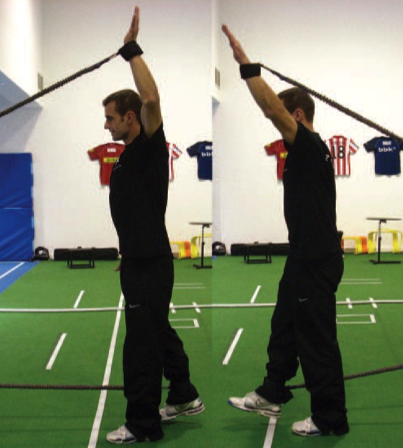
Abdominals
The abdominal muscles play a role in reducing overload of the primary kicking muscles (hip flexors and quadriceps) and maintaining good spinal posture and alignment during the kicking motion[4]. Training specificity is important as with every exercise you perform in a strengthening program. With this in mind, the example given in figure 4 provides a movement pattern similar to that seen in the kicking motion. Resistance can be provided through the use of strength bands or a cable machine.
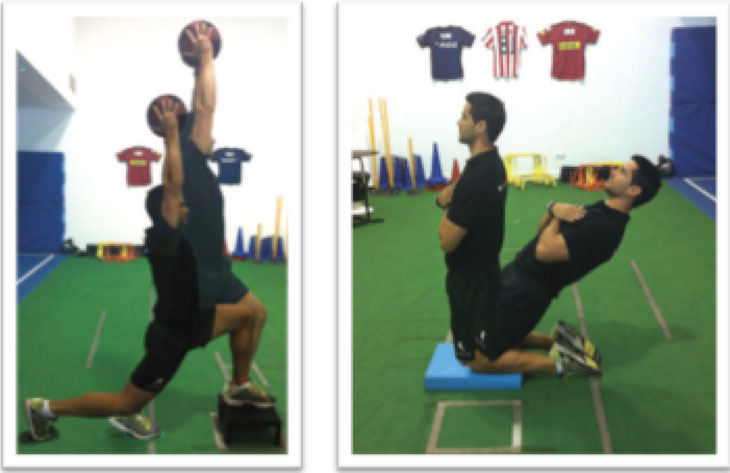
Conclusion:
In summary, quadricep injuries and in particular those to rectus femoris are a commonly seen problem
in football players at all levels. Identifying players who may be at risk is the first step. The
implementation of effective rehabilitation strategies is critical to prevent reoccurence and/or first time
injury in players.
***
 A former Premiership winning player at South Hobart FC, Josh is a physiotherapist with extensive experience dealing with hip and groin pain in football players. He is currently undertaking his PhD, looking at hip and groin pain in soccer players. More information about his research can be found at http://semrc.blogs.latrobe.edu.au/force-trial/
A former Premiership winning player at South Hobart FC, Josh is a physiotherapist with extensive experience dealing with hip and groin pain in football players. He is currently undertaking his PhD, looking at hip and groin pain in soccer players. More information about his research can be found at http://semrc.blogs.latrobe.edu.au/force-trial/
References:
- Woods, C., et al., The Football Association Medical Research Programme: an audit of injuries in professional football—analysis of preseason injuries. British Journal of Sports Medicine, 2002. 36(6): p. 436-441.
- Orchard, J. and H. Seward, Epidemiology of injuries in the Australian Football League, seasons 1997–2000. British Journal of Sports Medicine, 2002. 36(1): p. 39-44.
- Ekstrand, J., M. Hagglund, and M. Walden, Epidemiology of muscle injuries in professional football (soccer). Am J Sports Med, 2011. 39(6): p. 1226-32.
- Mendiguchia, J., et al., Rectus femoris muscle injuries in football: a clinically relevant review of mechanisms of injury, risk factors and preventive strategies. British journal of sports medicine, 2013. 47(6): p. 359-366.
- Brukner, P. and D. Connell, ‘Serious thigh muscle strains’: beware the intramuscular tendon which plays an important role in difficult hamstring and quadriceps muscle strains. British Journal of Sports Medicine, 2015.
- Witvrouw, E., et al., Muscle flexibility as a risk factor for developing muscle injuries in male professional soccer players. A prospective study. Am J Sports Med, 2003. 31(1): p. 41-6.
- Fousekis, K., et al., Intrinsic risk factors of non-contact quadriceps and hamstring strains in soccer: a prospective study of 100 professional players. Br J Sports Med, 2011. 45(9): p. 709-14.
- Orchard, J.W., Intrinsic and extrinsic risk factors for muscle strains in Australian football. Am J Sports Med, 2001. 29(3): p. 300-3.
- DEANE, R.S., et al., EFFECTS OF HIP FLEXOR TRAINING ON SPRINT, SHUTTLE RUN, AND VERTICAL JUMP PERFORMANCE. The Journal of Strength & Conditioning Research, 2005. 19(3): p. 615-621.

